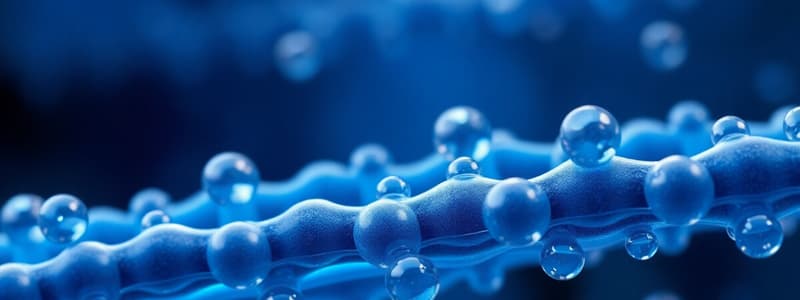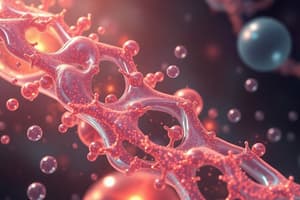Podcast
Questions and Answers
What type of fatty acids are considered important components of a heart-healthy diet?
What type of fatty acids are considered important components of a heart-healthy diet?
- Omega-3 fatty acids (correct)
- Saturated fatty acids
- Omega-6 fatty acids
- Trans fatty acids
Which property of fatty acids is influenced by the length and degree of unsaturation of their hydrocarbon chains?
Which property of fatty acids is influenced by the length and degree of unsaturation of their hydrocarbon chains?
- Solubility in water (correct)
- Color
- Taste
- pH level
Why do unsaturated fatty acids have lower melting points compared to saturated fatty acids of the same length?
Why do unsaturated fatty acids have lower melting points compared to saturated fatty acids of the same length?
- They are generally shorter in length.
- They are less concentrated in fats.
- They have a straight-chain structure.
- They contain more double bonds that disrupt packing. (correct)
What is the predominant configuration of double bonds in fatty acids?
What is the predominant configuration of double bonds in fatty acids?
Which fatty acid, known as an omega-3 fatty acid, is specifically mentioned as important for the retina?
Which fatty acid, known as an omega-3 fatty acid, is specifically mentioned as important for the retina?
What is the main function of cholesterol in the body?
What is the main function of cholesterol in the body?
Which statement accurately describes saponifiable lipids?
Which statement accurately describes saponifiable lipids?
What characterizes amphipathic molecules such as fatty acid salts?
What characterizes amphipathic molecules such as fatty acid salts?
What best describes nonsaponifiable lipids?
What best describes nonsaponifiable lipids?
Which of the following best categorizes lipids?
Which of the following best categorizes lipids?
What is a primary function of low density lipoproteins (LDLs)?
What is a primary function of low density lipoproteins (LDLs)?
What effect do trans fats have on LDL and HDL levels in the body?
What effect do trans fats have on LDL and HDL levels in the body?
How do trans fatty acids primarily enter the diet?
How do trans fatty acids primarily enter the diet?
What is a consequence of high triglyceride levels in the blood?
What is a consequence of high triglyceride levels in the blood?
What is a common daily intake range for trans fats that can have deleterious effects on health?
What is a common daily intake range for trans fats that can have deleterious effects on health?
What molecule replaces glycerol in sphingolipids?
What molecule replaces glycerol in sphingolipids?
Which type of glycolipid contains complex oligosaccharide chains with sialic acid residues?
Which type of glycolipid contains complex oligosaccharide chains with sialic acid residues?
What is one of the main functions of phospholipids in commercial products?
What is one of the main functions of phospholipids in commercial products?
What is the primary role of cholesterol in cell membranes?
What is the primary role of cholesterol in cell membranes?
Which statement accurately describes sphingolipids?
Which statement accurately describes sphingolipids?
What defines a globoside?
What defines a globoside?
Which of the following is NOT a component of sterols?
Which of the following is NOT a component of sterols?
What category of lipids does cerbrosides belong to?
What category of lipids does cerbrosides belong to?
Which of the following statements accurately describes lipids?
Which of the following statements accurately describes lipids?
What type of compound are triglycerides classified as?
What type of compound are triglycerides classified as?
Which component is not part of compound lipids?
Which component is not part of compound lipids?
What is the characteristic structure of steroids?
What is the characteristic structure of steroids?
What distinguishes saturated fatty acids from unsaturated fatty acids?
What distinguishes saturated fatty acids from unsaturated fatty acids?
Which of the following describes the physical properties of pure fats and oils?
Which of the following describes the physical properties of pure fats and oils?
What is the main role of fatty acids in living organisms?
What is the main role of fatty acids in living organisms?
Which fatty acid characteristic contributes to its overall nonpolar nature?
Which fatty acid characteristic contributes to its overall nonpolar nature?
What is an effect on the properties of lipids due to their hydrophobic nature?
What is an effect on the properties of lipids due to their hydrophobic nature?
Which of the following statements about waxes is true?
Which of the following statements about waxes is true?
What functional group distinguishes esters?
What functional group distinguishes esters?
What is the primary reaction to synthesize an ester?
What is the primary reaction to synthesize an ester?
Which fatty acid composition contributes to olive oil being liquid at 25˚C?
Which fatty acid composition contributes to olive oil being liquid at 25˚C?
What effect does partial hydrogenation have on vegetable oils?
What effect does partial hydrogenation have on vegetable oils?
Why is butter a soft solid at room temperature?
Why is butter a soft solid at room temperature?
What is an undesirable effect of partial hydrogenation?
What is an undesirable effect of partial hydrogenation?
What type of fatty acids are primarily present in beef fat?
What type of fatty acids are primarily present in beef fat?
What is the result of lipid-rich foods exposed to long-term oxygen?
What is the result of lipid-rich foods exposed to long-term oxygen?
Flashcards
Unsaturated Fatty Acids
Unsaturated Fatty Acids
Fatty acids with one or more double bonds in their hydrocarbon chain. These bonds cause kinks in the chain, making it difficult for the molecules to pack tightly together, which lowers their melting points.
Saturated Fatty Acids
Saturated Fatty Acids
Fatty acids with no double bonds in their hydrocarbon chain. These chains are straight and pack tightly together, increasing their melting points and making them solid at room temperature.
What determines fatty acid properties?
What determines fatty acid properties?
The physical properties of fatty acids, like their melting point and solubility in water, are primarily influenced by the length of their hydrocarbon chain and the number of double bonds present.
How does chain length and unsaturation affect solubility?
How does chain length and unsaturation affect solubility?
Signup and view all the flashcards
Why are fatty acids poorly soluble in water?
Why are fatty acids poorly soluble in water?
Signup and view all the flashcards
What are trans fats?
What are trans fats?
Signup and view all the flashcards
What is LDL cholesterol?
What is LDL cholesterol?
Signup and view all the flashcards
What is HDL cholesterol?
What is HDL cholesterol?
Signup and view all the flashcards
What are triglycerides?
What are triglycerides?
Signup and view all the flashcards
What are lipoproteins?
What are lipoproteins?
Signup and view all the flashcards
What are steroids?
What are steroids?
Signup and view all the flashcards
What is a saponifiable lipid?
What is a saponifiable lipid?
Signup and view all the flashcards
What is a nonsaponifiable lipid?
What is a nonsaponifiable lipid?
Signup and view all the flashcards
Explain the process of saponification.
Explain the process of saponification.
Signup and view all the flashcards
Define an amphipathic molecule.
Define an amphipathic molecule.
Signup and view all the flashcards
Ester Functional Group
Ester Functional Group
Signup and view all the flashcards
Ester
Ester
Signup and view all the flashcards
Esterification
Esterification
Signup and view all the flashcards
Triacylglycerol
Triacylglycerol
Signup and view all the flashcards
Degree of Saturation
Degree of Saturation
Signup and view all the flashcards
Oxidation of Unsaturated Fats
Oxidation of Unsaturated Fats
Signup and view all the flashcards
Partial Hydrogenation
Partial Hydrogenation
Signup and view all the flashcards
Phospholipids
Phospholipids
Signup and view all the flashcards
Sphingolipids
Sphingolipids
Signup and view all the flashcards
Glycolipids
Glycolipids
Signup and view all the flashcards
Gangliosides
Gangliosides
Signup and view all the flashcards
Globosides
Globosides
Signup and view all the flashcards
Cerebrosides
Cerebrosides
Signup and view all the flashcards
Emulsifying Agent
Emulsifying Agent
Signup and view all the flashcards
Cholesterol
Cholesterol
Signup and view all the flashcards
What are lipids?
What are lipids?
Signup and view all the flashcards
What are the properties of lipids in relation to water?
What are the properties of lipids in relation to water?
Signup and view all the flashcards
What are simple lipids?
What are simple lipids?
Signup and view all the flashcards
What are compound lipids?
What are compound lipids?
Signup and view all the flashcards
What are fatty acids?
What are fatty acids?
Signup and view all the flashcards
How are fatty acids classified?
How are fatty acids classified?
Signup and view all the flashcards
What are phospholipids?
What are phospholipids?
Signup and view all the flashcards
What are waxes?
What are waxes?
Signup and view all the flashcards
Study Notes
Biomolecules
- Biomolecules are essential components of all living organisms.
- They include proteins, carbohydrates, lipids, and nucleic acids.
- Lipids are organic molecules composed mostly of carbon, hydrogen, and oxygen.
- They are used in cell membranes, energy storage, insulation, and hormones.
- Lipids are insoluble in water but soluble in non-polar organic solvents.
- They are hydrophobic or amphipathic.
Classification of Lipids
- Lipids are not polymers.
- They are classified based on molecular structures.
- Three major subclasses are recognized:
- Simple lipids: Fats and oils yield fatty acids and glycerol upon hydrolysis, and waxes yield fatty acids and long-chain alcohols upon hydrolysis.
- Compound lipids: Phospholipids yield fatty acids, glycerol, phosphoric acid, and a nitrogen-containing alcohol upon hydrolysis, glycolipids yield fatty acids, sphingosine or glycerol, and a carbohydrate upon hydrolysis, and sphingolipids yield fatty acids, sphingosine, phosphoric acid, and an alcohol component upon hydrolysis.
- Steroids: These compounds contain a phenanthrene structure and have a unique carbon skeleton with four fused rings. They differ structurally from lipids based on fatty acids.
Physical Properties of Lipids
- Lipids can be liquids or non-crystalline solids at room temperature.
- Pure fats and oils are typically colorless, odourless, and tasteless.
- Their colours, odours, and flavours come from foreign substances absorbed.
- Fats and oils are less dense than water and poor conductors of heat and electricity.
Key Principles of Fatty Acids
- Fatty acids (FAs) are water-insoluble hydrocarbons used for cellular energy storage.
- They are highly reduced, thus a rich source of stored chemical energy for cells.
- Storage as triacylglycerols is highly efficient because water is not needed to hydrate the stored fat.
Fatty Acids
- Fatty acids are carboxylic acids with hydrocarbon chains ranging from 4 to 36 carbons long (typically 12-20).
- They contain polar carboxylic acid groups and nonpolar hydrocarbon tails, that make them overall nonpolar.
Standard Nomenclature for Fatty Acids
- In some fatty acids, the chain is fully saturated (no double bonds).
- Others contain one or more double bonds (unsaturated).
- Some contain three-carbon rings, hydroxyl groups, or methyl-group branches.
- Two naming conventions exist:
- One convention numbers the carbons from the carboxyl carbon (C-1).
- Another convention numbers the carbons from the methyl carbon (ω). The position of double bonds is designated using ω.
Physical Properties of Fatty Acids
- Fully saturated fatty acids have free rotation around carbon-carbon bonds, resulting in great flexibility of their hydrocarbon chain.
- Saturated fatty acids can pack tightly in nearly crystalline arrays.
- Unsaturated fatty acids have cis double bonds, causing kinks in their hydrocarbon chains, hindering tight packing.
- Unsaturated fatty acids have lower melting points than saturated fatty acids of the same chain length.
Common Saturated Fatty Acids
- This table provides characteristics of some naturally occurring saturated fatty acids. The table includes: Carbon skeleton, Structure, Systematic name, common name, melting point (°C), and solubility in water (mg/g solvent) and benzene.
Common Unsaturated Fatty Acids
- Includes: Carbon skeleton, Structure, Systematic name, common name, melting point (°C), and solubility in water (mg/g solvent) and benzene.
- Unsaturated fatty acids, like linoleic acid and linolenic acid, are essential fatty acids that the body cannot produce on its own.
Simple Lipids
- Fats and oils are the most abundant lipids in nature.
- They are called triacylglycerols because of their ester structure.
- They're composed of three fatty acids connected to glycerol.
- They're classified based on physical state at room temperature (solid fats vs. liquid oils).
Structure of Triacylglycerols
- The simplest lipids constructed from fatty acids are triacylglycerols.
- They're composed of three fatty acids in ester linkage with a single glycerol molecule.
- Most naturally occurring triacylglycerols are mixed, containing two or more different fatty acids.
- These molecules are nonpolar.
Esters
- Esters are distinguished by a functional group containing oxygen.
- Chemically, esters are synthesized by reacting a carboxylic acid with an alcohol.
Fatty Acid Composition of Food Fats
- Most natural fats are complex mixtures of simple or mixed triacylglycerols.
- The melting points of these fats depend on their fatty acid compositions.
- Olive oil tends to be liquid at 25°C due to its high proportion of long-chain unsaturated fatty acids.
- Butter's higher saturated fatty acid content results in a solid state at 25°C.
Lipoproteins
- Lipoproteins transport water-insoluble lipids (e.g., triglycerides, phospholipids and cholesterol) in the blood.
- They contain both lipids and proteins.
- Examples include: Chylomicrons, LDLs, and HDLs.
Triglycerides
- Triglycerides are a storage form of fatty acids in mammals.
- Blood tests often measure triglyceride levels.
- High triglyceride levels can indicate risk for atherosclerosis.
Fat Stores in Cells
- Triacylglycerols are a form of energy storage in cells as microscopic oily droplets.
- In vertebrates, specialized fat cells (adipocytes) store large amounts as fat droplets.
- Plant seeds and adipocytes contain lipases, enzymes that catalyze the hydrolysis of stored triacylglycerols to release fatty acids.
- Triacylglycerols store more energy per gram than polysaccharides.
- Fat stores insulate animals from cold temperatures.
Adipose Tissue & Fat
- Adipose tissue cushions and insulates organs.
- Lipids in fats carry flavours and vitamins to tissues.
- Fatty acids form vital compounds like prostaglandins and phospholipids.
Difference between saponifiable and non-saponifiable lipids
- Saponifiable lipids contain ester groups, undergoing hydrolysis.
- Non-saponifiable lipids do not contain ester groups and cannot be hydrolyzed.
Steroids & Their Roles
- Sterols includes compounds with a characteristic four-ring structure.
- Cholesterol is a steroid that regulates cell membrane fluidity and is a precursor for other steroids.
- Steroid hormones are signaling molecules, with functions throughout body metabolism and cell processes. Examples of sterols include Cholesterol, sex hormones, Vitamin D, and bile acids.
Waxes
- Biological waxes are esters of long-chain saturated and unsaturated fatty acids with long-chain alcohols.
Membrane Lipids
- Membrane lipids contain glycerol or sphingosine as the backbone.
- Glycerophospholipids and sphingolipids are examples of membranes.
- Phospholipids are a major component of biological membranes.
- Phospholipids are amphipathic, exhibiting both hydrophilic and hydrophobic properties.
- Glycolipids are important for cell-cell recognition and are used as blood group antigens.
Phospholipids and Glycolipids
- Phospholipids and glycolipids are amphipathic molecules that are important components of biological membranes.
- These molecules have a hydrophilic polar head group and hydrophobic tails.
Phospholipids
- Glycerophospholipids and sphingolipids are the two types of phospholipids.
- Glycerophospholipids have glycerol as a backbone; sphingolipids use sphingosine as a backbone.
- In glycerophospholipids, one of the fatty acids in the triacylglycerol is replaced by a phosphate-alcohol group.
- Lecithin is a type of phospholipid used as an emulsifier in food products like mayonnaise.
Sphingolipids
- Sphingolipids differ structurally from glycerophospholipids in that they have a sphingosine backbone instead of glycerol.
- Sphingosine replaces the glycerol component of a glycerophospholipid.
Glycolipids
- Some sphingolipids have sugars attached to the alcohol portion of the molecule.
- Glycolipids include gangliosides and globosides, significant for cell recognition and blood group antigens.
- Cerebrosides are important components for insulation in nerve fibers.
Trans Fats in Foods
- Unsaturated fatty acids, when exposed to oxygen, can react and create aldehydes & ketones.
- To improve shelf-life, some oils undergo partial hydrogenation, converting some cis double bonds to trans double bonds.
- This process changes the melting point of oils and creates trans fatty acids.
- Dietary intake of trans fats is linked to cardiovascular disease.
Commercial Hydrogenation of Fatty Acids
- Partial hydrogenation converts 'cis' unsaturated fatty acids to 'trans' unsaturated fatty acids.
An Unwanted Byproduct
- Trans fats increase low-density lipoprotein (LDL) levels.
- LDL is implicated in the deposit of cholesterol in the arteries (rather than transport to cell membranes).
- Atherosclerosis can result from this cholesterol build-up.
Studying That Suits You
Use AI to generate personalized quizzes and flashcards to suit your learning preferences.




